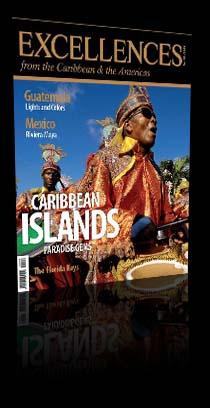A full color table
Color, taste and movement. There’s nothing boring in Caribbean cuisine, not even the way of cooking, the ingredients or the way of eating. It’s about a blend of culture, cooking habits, of spices and textures.
The great deal of aromatic plants, spices and local products –tomatoes, pumpkins, peppers, beans and an assortment of tropical fruits– makes cooking in the Antilles a mixture of bittersweet, or spicy and refreshing tastes in which seafood is the name of the game. And unlike other parts of the world, they are hitched up with such tropical fruits as coconuts and pineapples without losing their touch on the table. Instead, they simply give in part of their kingdom to vegetables, fruits and all kinds of fritters. As a blend of Spanish, Asian, African, English and a multitude of European cultures, the typical dishes of over 700 islands that embrace a total surface of 2,508 miles from North America to South America vary a lot from people to people, though shellfish and seafood, vegetables and fruits, the different fritters are common denominators for all of them. A typical Caribbean table almost always starts with fruit and vegetable salads spiced with a rum-based cocktail, followed by some kind of chicken or shellfish cold salad –a good way to quench the sweltering tropical heat– or a stew made of multiple root vegetables and meats, a reminiscence of the olla española that, contrary to the former effect, raises body temps after the initial cooling-off. The main course will invariably be well seasoned with a mixture of garlic, onion, tomatoes, sweet or spicy peppers and an array of aromatic herbs. That’ll be the rule of the house when it comes to shellfish, seafood or tenderloin steak served at the purest European style. Among the most sought-after meats, pork, chicken, mutton and veal seasoned with spices and vegetables, aromatized with chili peppers, cumin, gingerbread, curry or broiled in rum are very common. Whether it’s fish or beef, meats are usually served together with rice or beans, as well as fried root vegetables or fritters, as well as with good helpings of salad. Wrapping up the meal with well-sweetened desserts –in which fruits in syrup take the lead– a cup of strong coffee, a good cigar and a drink of rum, with a few coconuts helping us to wash down so much food, is the typical image of any nook and cranny of the Caribbean. The new winds of the French nouvelle cuisine have blown in over here, the winds of molecular gastronomy, of author’s cuisine. Yet all of them have succumbed to the blast of colors and tastes the tropic has to offer, to the exuberance of fruits and vegetables and spices. And many times, the new trends have been assimilated more as a decorative touch rather than as a true reason. Thus, roast pork, grilled lobster, black beans and rice and even the vegetable salads now put on their glad rags, take on crunchy or foamy textures, accept geometrical shapes and make up fancy combinations, yet they never ever lose their original taste. Furthermore, the Caribbean cuisine does hold a candle to the kind of healthy food some people talk about. Except for the fritters and the pork meat, great quantities of fruits and vegetables guarantee a good intake of salts, minerals and vitamins, let alone that they help make digestion a whole lot easier. On the other hand, spices chip in plenty of antioxidants, increase salivation and secretion of neuro-aminic acid and exosamine, thus keeping the teeth free of food wastes, cutting down on the number of bad teeth and gum and mouth infections. There’s a debate going on today on how to improve Caribbean cuisine, a discussion that many times leans more to service matters and presentation rather than to taste. Some people look to European chefs and pin all their hopes on them, and they keep forgetting that the secrets of those Old World master cooks’ sauce recipes were largely found in this way of cooking of this neck of the woods and in their quasi-crazy and bold –yet seductive- way of mixing ingredients that in the light of cold reasoning could never be blended. Other, though, prefer to stick to their roots, leaving experiments to the European cuisine and fancy restaurants. And it’s not because their lack imagination or are short of thoughts to do so, but just because they know it’s the traditional thing what visitors come looking for around here. They want not only to let the endless sunshine, the evergreen and the exuberance of the Caribbean enter their skins and they eyes, but also their mouths. They just want a new taste to be there too, and for forever more.
The Caribbean cuisine does hold a candle to the kind of healthy food some people talk about. Great quantities of fruits and vegetables guarantee a good intake of salts, minerals and vitamins























































































































